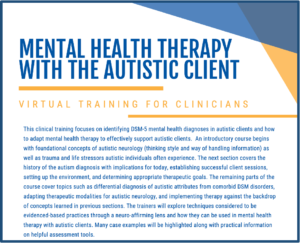Autism and the Sensory System
Part Eight: The Role of Interoception: The Eighth Sensory System
With Kelly Mahler, MS, OTR/L
Interoception is the sense that allows us to feel sensations from the inside of our body like a growling stomach, or full bladder or tight muscles (Craig, 2002). These internal sensations can serve as important clues to our emotions (Craig, 2002; Critchley et al., 2004; Herbert, Herbert, & Pollatos, 2011; Herbert, Pollatos, & Schandry, 2007; Pollatos, Gramann, & Schandry, 2007; Pollatos et al., 2005). For example, noticing a growling stomach is a clue that we are hungry, or noticing a full bladder is a clue that we have to go to the bathroom, or noticing tight muscles is a clue that we are frustrated. This body-emotion connection provides valuable information about the world around us and within us, information about the way our body is responding to the situation at hand. For example, noticing tight muscles and recognizing it as a clue of frustration provides us with valuable information about our current situation, our body serving as an alert that something might be off around us. This body-emotion connection urges us into action, to seek out a solution that will help us regain a comfortable feeling body and emotion (e.g. seek help; request that an unmet need is fulfilled; take a quite break) (Jackson, Parkinson, Kim, Schüermann, & Eickhoff, 2011).
Taking In Interoceptive Information
Just as with all other seven senses, autistics can have differences in the way they take in interoception information. Internal sensations can be
too big(e.g. where many internal sensations are amplified, noisy and can cause extreme internal confusion)
too small (e.g. where internal sensations can be muted or even go completely unnoticed) or
distorted (e.g.where internal sensations can be vague or not clear enough to provide specific detail about the exact location or quality of the sensation)
Processing Interoceptive Information
Additionally, the processing style of autistics can impact the interpretation of the signals sent by the sense of interoception.
Linear processing of interoceptive information that in turn informs self-understanding of emotional state may happen in two different ways
Linear processing style one
The physical feelings connected to emotions may be processed one at a time:
- first noticing the heart beating faster
- next noticing hands shaking
- then noticing tight feeling in chest
Due to this linear processing style these sensations are not linked together into the big picture of feeling anxious. This makes learning to label emotions extremely difficult and yet we see this goal over and over on a student’s IEP or a client’s therapy treatment plan.
Linear processing style two
With this linear processing style an autistic might
- first process a sound like a loud noise
- then process an interoceptive sensation like a tight feeling in chest
Because these two sensations were processed in a linear fashion the sensations are not linked together. This makes it impossible for the individual to process the experience as a whole. Thus the informative learning mechanism available to most people – that the loud noise caused my chest to feel tight which in turn means that now I feel anxious – is not going to happen automatically for individuals whose brain processes sensory information in this manner.
Nondiscriminatory processing, which refers to all incoming information getting processed equally means all interoceptive sensations noticed may be automatically interpreted to be of equal importance. This makes it difficult to figure out which sensations are relevant to the situation at hand.
Imagine if while eating, you were to notice all of these things as if they were equally salient to eating:
- a slow heartbeat
- warm hands
- fidgety legs
- heavy eyes
- tight, heavy stomach
In nondiscriminatory processing the sensory system is not able to discriminate and then track the sensations relevant to eating. The pairing of tight, heavy stomach to being full is does not happen. Individuals affected in this way are prone to overeat.
Monochannel processing, where one sensory system is used to process all information, poses a wide variety of interoceptive difficulties. For example, if I am working on learning when I am full and some days my one channel to process is interoception then I can feel sensations from my stomach. This will help my learning! But other days my one channel could be any one of the other seven sensory system. How will I make any progress at all about feeling full on those days!
Storing and Retrieving Interoceptive Information
As with all other sensations, the storingandretrieving of interoception information can be enhanced by teaching categorizationand using deliberate practice to develop critical mass. Here are some examples:
- teach mini categories first (e.g. the category of hand sensations or, in other words, providing the category of ‘all of the different ways that my hands can feel’)
- then put these mini-categories together into a larger category that represents entire body sensations (or the category of ‘all the different ways my entire body can feel’)
- use deliberate practice designed to give concrete meaning to the words within a mini category (e.g. when washing hands in warm water, noticing the way the hands can feel ‘wet’ and ‘warm’)
- systematically categorizing the way each individual body part can feel, giving plenty of specific practice (make it a game or a predictable routine), can help move towars critical mass
- use deliberate practice by playing a game or engaging in a routine that draws attention to noticing the ways the entire body can feel is another essential step in moving toward attaining an interoceptive critical mass (Mahler, 2019)
As awareness of interoceptive signals and their meaning expands over time by using the above bulleted techniques, critical mass can develop.This means individuals can come to not only experience interoceptive physical sensations but also learn to pair meaning to that sensation. Thus, a client may come to know that when he notices shaky hands, fast heart and a tight chest, it means he is anxious.
As discussed, interoception underlies our ability to clearly detect our own emotions in the moment. This body-emotion connection is now well-validated and understood in research.
Furthermore, the awareness of our own emotions has been found to underlie the ability to quickly read the emotions of other people. In other words, research has found that a solid body-emotion connection is first needed for understanding of our own emotions, and once that connection has been established, only then can we come to understand or read the emotions of other people (Adolfi et al, 2017; Singer et al, 2004; Cook, Brewer, Shah, & Bird, 2013; Grynberg & Pollatos, 2015; Gu et al, 2012; Shah et al, 2017). It is essentially a self first, other people second phenomenon. In other words, we need to understand our own body and emotions before we are ready to intuitively understand others.
Difficulty reading the emotions of others, whether a conversation partner or a character in a novel, is typically due to a skipped step in the developmental progression of emotions (e.g. missing interoception information). Ensuring that emotions are learned from the inside out is an essential skill for reading comprehension: being able to quickly infer the emotions of characters in a story. It also goes a long way in making comprehension of life in the world around us easier.
Thanks, Kelly Mahler! Now, I (Judy), would like to share with you a personal example from my growing up years that illustrates the impact sensory disregulation can have on literacy instruction.
I like to think I am fairly intelligent with good cognitive resources to bring to the task. After all I received a nearly perfect score on the ACT College Entrance Exam so there is some validity to my assumptions in this department! I tell you of my normal intelligence because when it comes to reading, my cognitive capability isn’t the only thing that matters.
When my sensory system is not well regulated my comprehension fades. Even though I am able to read the words with fluency I do not know what they mean. Because of this oral reading fluency and because of my intelligence teachers often made assumptions about my character on days my comprehension was low or altogether missing. I have been called lazy, stubborn and told that I didn’t care about my grades and that I must want to fail during my elementary years. In High School I was told that I must think I am too good to answer the teacher’s questions and was actually punished for failing to answer comprehension related questions! I had to move my desk to the hall when the bell rang and sit in that desk until I was ready to answer while the rest of the students moved on through their class rotations.
I didn’t have the words to explain my truth at the time, but then I heard one teacher say to another, “She won’t answer questions today” in an exasperated voice. After hearing that, each time I was asked if I was ready to answer the questions I co-opted that phrase knowing that teachers have all the right answers. I repeated my teacher’s words along with her irritated voice saying, “She won’t answer questions today.”
No matter how many times I repeated this right answer it did not work out for me that day. I sat there, shamed in front of my peers, for a few more hours. When the dismissal bell sounded I got up and left with the other students.
Some days I could comprehend what I read and some days I couldn’t – a lot depended on my sensory regulation in the moment. As a child I did not know the information I do today and thus had no way to explain what was happening to my teachers. Instead, I believed them. They were the adults. They were in charge. I indeed must be lazy and stuck up just like they said.
Unfortunately, experiences like this, where others made assumptions based on the behavior I exhibited happened frequently. Regardless of the techniques employed – negative or positive – none of it gave me access to comprehension when I was disregulated. Even as an adult, having a well regulated sensory system before I begin to read anything makes a huge difference. In fact, I am unable to take in written information when I am not well regulated. I can read the words both silently and aloud, but am unable to comprehend them. Over the years I have come to learn that this differential access to comprehension has nothing to do with my character or intelligence, but instead has to do with the fact of my autistic neurology.
– from Autistically Thriving: Reading Comprehension, Conversational Engagement, and Living a Self-Determined Life Based on Autistic Neurology.
Note: This blog completes the series below.
Autism and the Sensory System
Part One: Introduction
Part Two: Taking In Sensory Information
Part Three: Processing Sensory Information
Part Four: Processing Delays
Part Five: Storing and Retrieving Information
Part Six: Categorization of Information
Part Seven: Critical Mass Development
Part Eight: The Role of Interoception, The Eighth Sensory System

REFERENCES
Adolfi, F., Couto, B., Richter, F., Decety, J., Lopez, J., Sigman, M., Manes, F., & Ibáñez, A. (2017). Convergence of interoception, emotion, and social cognition: A twofold fMRI
meta-analysis and lesion approach. Cortex88, 124–142.
Critchley, H. D., Wiens, S., Rotshtein, P., Öhman, A., & Dolan, R. J. (2004). Neural systems supporting interoceptive awareness. Nature Neuroscience, 7(2),189-195.Cook, R., Brewer, R., Shah, P., &Bird, G. (2013). Alexithymia,notautism,predicts poor recognition of emotional facial expressions.Psychological Science, 24(5),723.
REFERENCES
Endow, J. (2019). Autistically Thriving: Reading Comprehension, Conversational Engagement, and Living a Self-Determined Life Based on Autistic Neurology. Lancaster, PA: Judy Endow.
Endow, J. (2012). Learning the Hidden Curriculum: The Odyssey of One Autistic Adult. Shawnee Mission, KS: AAPC Publishing.
Endow, J. (2006). Making Lemonade: Hints for Autism’s Helpers. Cambridge, WI: CBR Press.
Endow, J. (2013). Painted Words: Aspects of Autism Translated. Cambridge, WI: CBR Press.
Endow, J. (2009). Paper Words: Discovering and Living With My Autism. Shawnee Mission, KS: AAPC Publishing.
Endow, J. (2009). Outsmarting Explosive Behavior: A Visual System of Support and Intervention for Individuals With Autism Spectrum Disorders. Shawnee Mission, KS: AAPC Publishing.
Endow, J. (2010). Practical Solutions for Stabilizing Students With Classic Autism to Be Ready to Learn: Getting to Go. Shawnee Mission, KS: AAPC Publishing.
Myles, B. S., Endow, J., & Mayfield, M. (2013). The Hidden Curriculum of Getting and Keeping a Job: Navigating the Social Landscape of Employment. Shawnee Mission, KS: AAPC Publishing.
.Grynberg,D.&Pollatos,O.(2015).Perceivingone’sbodyshapesempathy. Physiology and Behavior, 140. 54-60.
Gu, X., Gao, Z., Wang, X., Liu, X., Knight, R. T., Hof, P. R., & Fan, J. (2012). Anteriorinsularcortexisnecessaryforempatheticpainperception.Brain,135(9),2726-2735.
Herbert, B. M., Herbert, C., & Pollatos, O. (2011). On the relationship between interoceptive awareness and alexithymia: Is interoceptive awareness related to emotional awareness? Journal of Personality, 79(5), 1149-1175.Herbert, B. M., Pollatos, O., & Schandry, R. (2007). Interoceptive sensitivity and emotion processing: An EEG study.International Journal of Psychophysiology, 65(3), 214-227.
Jackson, S. R., Parkinson, A., Kim, S. Y., Schüermann, M., & Eickhoff, S. B. (2011).Onthefunctionalanatomyoftheurge-for-action.CognitiveNeuroscience,2(3-4),227-243.
Mahler, K. (2019). The Interoception Curriculum: A step-by-step guide to developing mindful self-regulation. Lancaster, PA: Kelly Mahler.
Mahler, K. (2016). Interoception the Eighth Sensory System:Practical solutions for improving self-regulation, self-awareness and social understanding of individuals with autism spectrum and related disorders. Shawnee Mission, KS: AAPC Publishing.
Myles, B. S., Endow, J., & Mayfield, M. (2013). The Hidden Curriculum of Getting and Keeping a Job: Navigating the Social Landscape of Employment.Shawnee Mission, KS: AAPC Publishing.
Pollatos, O., Gramann, K., & Schandry, R. (2007). Neural systems connecting interoceptive awareness and feelings. Human Brain Mapping, 28(1), 9-18.
Pollatos, O., Kirsch,W., & Schandry, R. (2005). On the relationship between interoceptive awareness, emotional experience, and brain processes. Cognitive Brain Research, 25(3),948-962.
Shah, P., Catmur, C., & Bird, G. (2017). From heart to mind: Linking interoception, emotion, and theory of mind. Cortex. http:// dx.doi.org/10.1016/j.cortex.2017.02.010. Website accessed 2019.
Singer, T., Seymour, B., O’Doherty, J., Kaube, H., Dolan, R. J., & Frith, C. D. (2004). Empathy for pain involves the affective but not sensory components of pain. Science, 303(5661), 1157-1162.





